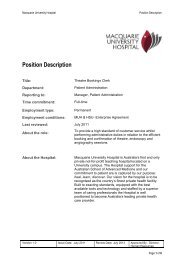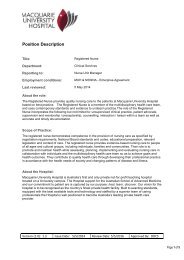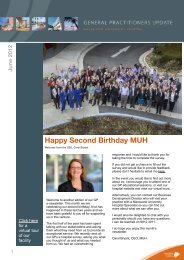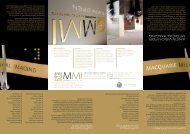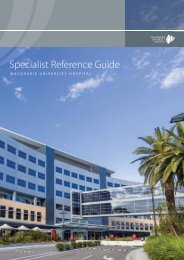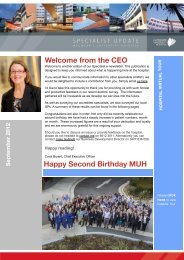Plenary Oral Presentations - Macquarie University Hospital
Plenary Oral Presentations - Macquarie University Hospital
Plenary Oral Presentations - Macquarie University Hospital
Create successful ePaper yourself
Turn your PDF publications into a flip-book with our unique Google optimized e-Paper software.
16 th International Meeting of the Leksell Gamma Knife ® SocietyMarch 2012, Sydney, AustraliaPH-200International Leksell Gamma Knife Calibration Survey– Final Results1,3Josef Novotny Jr., 2 Marc Desrosiers, 1 Jagdish Bhatnagar, 3 Josef Novotny, 4 Masaaki Yamamoto,1Saiful Huq, 2 James Puhl, 5 Dade Lunsford1Department of Radiation Oncology, <strong>University</strong> of Pittsburgh Cancer Institute, Pit2National Institute of Standards and Technology, US Department of Commerce, Gaith3Department of Medical Physics, Na Homolce <strong>Hospital</strong>, Prague, Czech Republic4Katsuta <strong>Hospital</strong> Mito Gamma House, Hitachinaka, Japan5Department of Neurological Surgery, <strong>University</strong> of Pittsburgh Medical Center, PitObjective: Survey approximately 100 Leksell Gamma Knife (LGK) units worldwide to 1) gather detailedinformation about calibration procedures and to 2) measure output of the surveyed LGK units.Methods: Each participant of the project received a LGK calibration questionnaire seeking thefollowing information: LGK model, calibration protocol, phantom, and ion chamber used for calibration,LGK calibration personnel, whether independent verification of calibration was performed, andrelative collimator output factors used. Alanine dosimeters were used to measure the dose rate of eachsurveyed LGK unit and these results compared with calibration data.Results: To date, 70 LGK units from 66 different centers spanning 15 different countries haveparticipated in this study (35 North America, 13 Europe, 21 Asia and 1 South America). Thecalibration protocols used are: AAPM TG21 (26), AAPM TG51 (7), IAEA TRS277 (1), IAEATRS398 (29), NPL Code of Practice (5) and DIN 6800-2 (2). ELEKTA ABS phantom was used in 65(93%) and ELEKTA solid water phantom in 5 (7%) units. Ion chambers most frequently used forthe calibration are: PTW 31010 (0.125 cm3) 26 times (37%), Exradin A16 (0.007 cm3) 12 times(17%) and Capintec PR-05P (0.070 cm3) 11 times (16%). Calibration of the LGK was performed byan on-site physicist in 52 (75%) cases, by ELEKTA physicist in 17 (24%) cases and in 1 (1%) casecalibration was done by a consulting physicist. Independent verification was done only in 31 (44%)cases; RPC, IAEA or similar audit was done only in 20 (29%) cases. All LGK units surveyed arecurrently using the default values for collimator relative output factors. Observed deviations betweenLGK users reported calibration and alanine dosimetry measurements were of small magnitude withmean value of 1.6%. In total 63 (90%) LGK units were within 3% deviation. None of measured unitsexceeded 4% deviation in calibration.Conclusions: Different calibration procedures, especially calibration protocols are used worldwide.Small but systematic deviation between LGK users reported calibration and alanine dosimetrymeasurements are observed for LGK centers in Europe and Asia where IAEA TRS398 protocolis used. This can be explained by the fact that the ABS plastic phantom is considered to be waterequivalent.62



